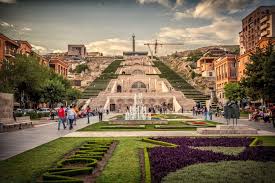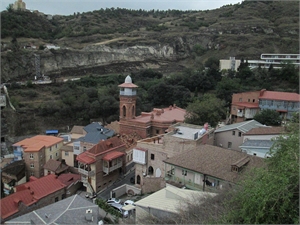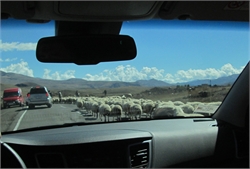Armenia
Armenia wasn’t on our travel radar until it seemed to make perfect sense. Although born in the U.S., my husband Oscar’s first language was Armenian. We were looking for a new travel adventure and even though our travels had taken us to Mexico, Italy, France, Austria, Turkey, Hungary and the Czech Republic, this trip would be our first to a destination where at least one of us spoke the language.
Travelling on Turkish Air’s Business Class, our overnight flight to Istanbul featured seats that converted to beds. We flew into Tblisi, Georgia, a wonderful city filled with history, art and outstanding new architecture. Like Armenia, it’s an early Christian country with its own written language.
Our visit was arranged by GoArmenia and we were escorted throughout our visit by Sergie and Aram. Tour manager Sergie handled the SUV and guide Aram provided daily history lessons. Day 1 started with the story of Noah and each day included another century of ‘begats’, rulers and conquests as Armenia—converted by St. Gregory in 301 as the first Christian nation—evolved through the ages adapting to various regimes conquering and being conquered up to the present day.
It is that indominable spirit that is the most lasting memory of our adventure. As a people, Armenians have rebounded from the most unspeakable horrors, including the murder and relocation of millions following the advent of the first World War. Much of classic Armenia, in ancient times, included most of what is now Turkey, its lands divided to the point it was forced to relinquish its beloved Mt. Ararat, where Noah and his ark (allegedly) came to rest.
We learned of the challenge for the country to rebound after nearly 100 years under Soviet domination and suffering a devastating earthquake. Still, it would take more than all that to quell the spirit of Armenia.

Thus, we began our 1,000-mile adventure through Armenia. On our first night we visited Gymuri, the second largest city, attending a concert in the main square. It seemed the entire city was there. The mood was festive and the music rocked. The next day we toured the old section, visiting artisan shops, marveling at the opportunity that abounds as the area continues to attract investment and renovate its historic quarter.
Throughout Armenia, we saw remnants of the Soviet years. The Russians literally closed up shop and left town—leaving the country forced to rebuild and reinvent itself.
Nowhere is this more apparent than in its capitol Yerevan. The city is bustling and vibrant, filled with museums, parks and cultural attractions. Seeking to honor rather than mourn its great loss, a visit to the Genocide Memorial was inspiring. Completed in 1995, the story of man’s inhumanity to man is told. At the eternal flame, my husband bowed his head in memory of his murdered grandfather and other unknown relatives.
Everywhere you look in Yerevan, the city is bustling. Lovely tree-lined streets and parks, shops and restaurants. A government plaza where Hollywood rock group System of The Down drew 100,000 to a free concert in 2015. Here we enjoyed a beautiful and colorful dancing fountain. Nearby government buildings and a Marriott Hotel now located in a refurbished building that formerly housed a Soviet ministry. Safety was never an issue throughout the country. As Adam explained, crime has diminished to such a degree that prisons are closing.
Art and architecture magnificently collide to form one of the city’s most visited cultural locations. The Cascade is a giant stairway linking the downtown Kentron area with the Monument neighborhood. The construction was launched in 1971 and completed in 1980. Further development was implemented between 2002 and 2009 when the complex was handed over to the American-Armenian Gerard Cafesjian. Inside the Cascade, underneath the exterior steps are escalators rising the length of the complex. Rooms in some of the landings compose the Cafesjian Museum of Art. The exterior stairs connect the multiple levels with fountains and sculptures and afford walkers unobstructed views of central Yerevan and Mount Ararat.
An international city, the area is dotted with a variety of restaurants, international as well as traditional. Armenian dining is definitely not a fast food affair. Beginning with meze, a scrumptous selection of hummus, breads, roasted vegetables, moving into meats usually cooked en brochette. Throughout Armenia, in the best hotels and the countryside, lunch was an all-afternoon affair.
Music and the arts flow like blood in Armenia’s veins. Opera, symphony, theatre, puppetry all have their own showcase theatres. The evening stroll is populated with theatre and concert goers.
Following our stay in the capitol, we head toward Karabakh through the countryside shared mostly with sheep and cattle. Agriculture abounds and the road is dotted with farm stands offering an extensive array of fruits and vegetables.
Almost daily, there was a spectacular monastery to visit. These ancient structures aren’t nestled in the villages, but rather up high canyons or gorges, perched on mountainsides. It’s these remote locations that have helped preserved them for thousands of years. Their vaulted chambers, some hewn out of the surrounding natural granite, embodies the strength of will and devotion of the Armenian people.
Bringing the past to the present is the ride to the Tatev Monastery on a mile long Swiss-made funicular. The venture is part of the tourism development project that is designed to benefit the entire region. At the top, adjacent to the monastery, local woman sell fried herbs and other wares. “Flying” over the villages, you spot new roofs and improvements indicating that the venture is benefiting the entire community.
As our guide, Aram, continues our history lesson as we journey through the countryside heading into the mountains and the beautiful spa resort of Jermuk. There’s skiing and hiking, mineral springs and waterfalls…a wonderfully magical place. Although it’s only the end of September while we’re there, you can tell that winter is on its way.
Passing through villages and a landscape best used for sheep grazing, we turn off the road in an extremely remote area. Here we come across a prehistoric site dating back many thousands of years. The rocks are positioned and drilled to see stars and planets, its meaning is lost to the ages.
Scenery in Armenia can only be described as National Park status. Mountains and gorges with streams and rivers flowing through. The road follows the water making its way through the steep rocky cliffs. Traffic is light; our main obstacle is an occasional herd of sheep or cattle in the road.
We enter Karabakh, a small independent country, situated between Azerbaijan and Armenia. This is the true frontier. War erupted between 1991 and 1994 and a siege ensued with one force shelling Karabakh’s capital Stepanakert until a group of Armenian commandos made their way through a steep gorge surprising the enemy force. A peace agreement was reached but the area is still on guard and relations with Azerbaijan are far from cordial.
There’s no question that when visiting outside of Yerevan, the capital, the country has its challenges. However, the warmth and industrious nature of the people, their hospitality bodes well for its future. Highlights of our trip were visits to villages where the government is encouraging people to welcome visitors. We visited bed and breakfasts, enjoying wonderful meals and meeting the proprietors—entrepreneurship is visible throughout the country from the cities to small villages.
Armenia’s challenges also include a lack of natural resources. A mountainous country, it is rich in minerals such as iron, copper, aluminum and other scarce metals and hydroelectric power. However, it lacks domestic sources for oil, coal and natural gas. It imports oil and natural gas from Russia and Iran. In turn, its exports to Iran include electricity generated by its hydroelectric facilities.
Perhaps, by far, Armenia’s greatest resource is its people. The Armenian Diaspora has scattered its people throughout the world. An industrious, artistic, intellectual race, they have enriched the countries they have adopted but haven’t forgotten their ancestral homeland. Everywhere there is evidence of their generosity. Names such as Simonian, Krikorian, Vartanian are acknowledged on countless innovative projects designed to assist Armenia and its people.
At the Tumo Center in Yerevan one of the most innovative facilities to encourage the interest of youth in the wonders of technology, hundreds of young people converge daily to take classes and create projects. The first two floors are devoted to the center and the upper floors house startups in a cooperative creative atmosphere. Here is where the future is being created.
In Dilijan, a beautiful city nestled in the mountains the United World College invites students from around the world to complete their last two years of high school in a unique residential program that encompasses literature, the arts and sciences. UWC Dilijan is a community working towards a more peaceful, equitable and sustainable world through a balanced, challenging and transformative education with people from diverse backgrounds. A tour of this campus and its international student body, you can imagine that if we are to have world peace, the seeds are being sown here as students from many countries and cultures share their dreams and aspirations. ese are the world leaders of tomorrow.
We returned to the U.S. with a new appreciation of Armenia and its people. Once again, our belief that tourism is the hope of the world is realized.